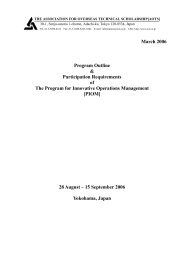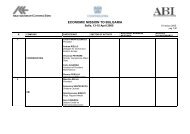Analysis of the Operation and Financial Condition of the Enterprise
Analysis of the Operation and Financial Condition of the Enterprise
Analysis of the Operation and Financial Condition of the Enterprise
You also want an ePaper? Increase the reach of your titles
YUMPU automatically turns print PDFs into web optimized ePapers that Google loves.
<strong>Analysis</strong> <strong>of</strong> <strong>the</strong> <strong>Operation</strong> <strong>and</strong> <strong>Financial</strong> <strong>Condition</strong> <strong>of</strong> <strong>the</strong> <strong>Enterprise</strong>Quantitative <strong>and</strong> qualitative measures for achievement <strong>of</strong> <strong>the</strong> goals <strong>of</strong> enterpriseowners - this part discusses quantitative measures to measure <strong>the</strong> success <strong>of</strong> <strong>the</strong>enterprise - e.g. market share, earnings before interest <strong>and</strong> taxes, customersatisfation, etc. This section provides questionnaires for audience to apply to <strong>the</strong>irown situations;Role <strong>of</strong> analysis in <strong>the</strong> activities <strong>of</strong> an enterprise – stresses financial analysis as <strong>the</strong>link between financial accounts <strong>and</strong> decision making.Techniques <strong>and</strong> methods <strong>of</strong> analysis - discusses horizontal, vertical analysis <strong>and</strong> <strong>the</strong>use <strong>of</strong> financial ratios.3. Applying <strong>Financial</strong> Statements for <strong>Enterprise</strong> <strong>Analysis</strong>This section emphasizes <strong>the</strong> role <strong>of</strong> financial reports as <strong>the</strong> basis for financial analysis.Balance sheet <strong>and</strong> P/L statement are emphasized in particular.This section covers: Role <strong>of</strong> financial statements in financial analysis <strong>and</strong> <strong>the</strong>ir founding principles - thispart covers such concepts as: <strong>the</strong> accruals principle <strong>and</strong> <strong>the</strong> going concern principle.The mainqualitative requirements to financial statements - reliability, comparability, etc. are alsodiscussed;Description <strong>of</strong> <strong>the</strong> main balance sheet items - this section focuses on how toconstruct <strong>the</strong> balance sheet. The emphasis here is on flexibility for <strong>the</strong> purposes <strong>of</strong>analysis. Questions are posed to <strong>the</strong> course users.Example: <strong>Analysis</strong> <strong>of</strong> <strong>the</strong> Balance SheetQuestions to be considered: What is <strong>the</strong> reason for changes in total assets? What is <strong>the</strong> structure <strong>of</strong> assets? Has <strong>the</strong> asset structure changed? What is <strong>the</strong> composition <strong>of</strong> long-term investments? Are <strong>the</strong>re any unused or inefficiently used assets? What is <strong>the</strong> proportion between equity <strong>and</strong> debt?In this way, target audience can immediately think <strong>of</strong> <strong>the</strong>ir own companies <strong>and</strong> situationsas material is being delivered to <strong>the</strong>m.This section also covers: Description <strong>of</strong> <strong>the</strong> main P/L statement items - as in discussion on <strong>the</strong> balance sheetaudience is encouraged to consider questions regarding pr<strong>of</strong>it, turnover, revenues <strong>and</strong>costs <strong>of</strong> <strong>the</strong>ir company. Role <strong>of</strong> financial analysis in financial planning - this part distinguishes by time threekinds <strong>of</strong> financial planning: Day-to-day financial estimates; Medium-term financial planning; Long-term financial planning;4. Applying <strong>Financial</strong> <strong>Analysis</strong> Measures6
















